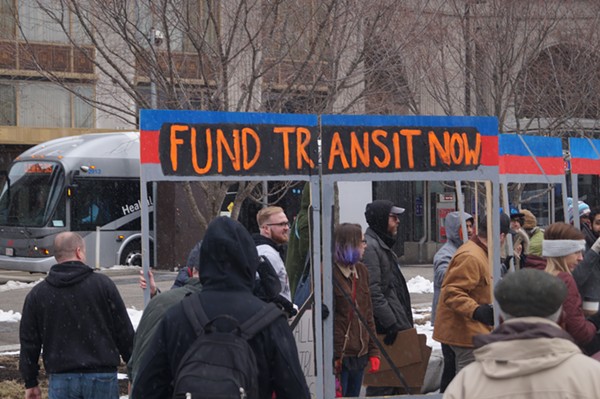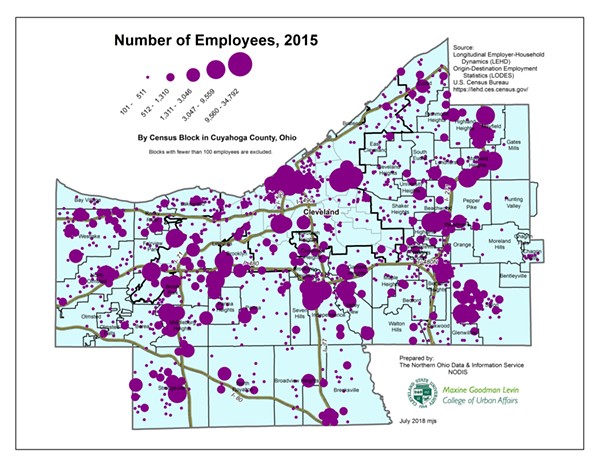Greater Cleveland RTA’s interim CEO and general manager yesterday presented his vision for the Future of Public Transit. In a two-hour session, Dr. Floun’say R. Caver highlighted key efforts of RTA, including priority corridors, micro-transit, multi-modal trips and adapting new technologies to serve as internal and external feedback loops. Caver noted that RTA must move beyond its role as a “service provider” to become a “mobility integrator,” meaning RTA can and should be a powerful actor in conversations around the form and function of regional transportation.
Pillar studies are underway to determine which practices will best serve the needs of all of RTA’s clients. These will include: a fare study, an economic impact study, a service redesign study, an efficiency study and operational review (with the help of GCP) and a rail car study.
The issue of spatial mismatch, or the misalignment between where people live and where jobs are, was a very strong theme throughout the presentation. Spatial mismatch can be clearly observed in this region — major job centers with lower wages and degree requirements are in the suburbs while many people who live in the suburbs earn their income in white collar professions in the city. The issue of a mismatch between the labor market and jobs has been discussed in a variety of civic settings across Cleveland in the past year. The Fund for Our Economic Future’s Two Tomorrow’s report discusses it, while the Unify Project and the joint venture between the county and a group of private funders known as Workforce Connect have emerged as potential solutions to this socioeconomic dilemma that has existed since the dawn of industrial relations.
But while others invest in Big Data and greater coordination among employers, Greater Cleveland RTA seeks to address a central component of this dilemma: the fact that people need a way to get from their residence to their job. RTA’s proposed solutions will, if they come to fruition, better connect service to job centers and make public transit more accessible, easy and enjoyable to use.
In interpreting the actions of the The Fund, RTA, the Unify Project and the general tone of civic discourse in Cleveland, it seems that if we can just move people to jobs, make sure top sectors are better coordinated and do a thing with an open ledger system, we can reduce the harmful side effects of spatial mismatch. But a look at some data and the use of a bit of critical thinking, leads me a slightly different conclusion.
According to 2017 estimates, in Cuyahoga County, 4.8% of the working population uses public transit to get to work and 13.3% of households do not have a car available. As would be expected, this number is higher in Cleveland, where 10% of the working population travels to work by public transit and 24.4% of households do not own a vehicle.
But the percentage of workers that use public transit is also higher-than-average in several suburbs including Bedford Heights, Cleveland Heights, East Cleveland, Euclid, Maple Heights, North Randall, Richmond Heights, Shaker Heights, Warrensville Heights and Woodmere. Similarly, the percentage of households without a vehicle is higher-than-average in Bedford Heights, East Cleveland, Euclid, Highland Hills, North Randall and Warrensville Heights.
In other words, in several cities in the county, many people do not have access to a private vehicle and these people are already taking buses to work. They already live in areas that are accessible via transit. So why isn’t there an equally strong endeavor in public and private funding and local civic attention to move jobs to them and build more affordable housing?
In mapping county employment data from 2015, it is clear that many of those same East Side suburbs, while surrounded by employment centers, are not major employment hubs. This not only means that workers must commute but that they often pay more in income taxes, as many of these cities do not offer a full tax credit for those who work outside of the city. Furthermore, since the cities cannot rely on local employers to provide a tax base, they must rely solely on the income and property taxes of homeowners — an unsustainable market that is heavily susceptible to sways in the economy (such as the housing/foreclosure crisis of 2007-2008 from which the East Side still has not recovered).
On the other hand, many businesses are located in outer urban areas where housing prices are too high to be affordable for the people who work there. And yet, while we’ve heard many calls for an inclusive, equitable and thriving economic sector, we’ve yet to hear the region’s new voices suggest a plan for affordable housing in Solon, Beachwood, Strongsville and Westlake.
At Monday’s briefing, Caver was asked whether RTA is working with other partners to improve workforce opportunities. Caver noted that RTA is providing a mobility perspective to their conversations but that it is not within their bandwidth to do economic and workforce development.
But is that really true, though? Spatial mismatch isn’t just happenstance. Local political actors are heavily involved in business retention practices, planning and zoning, taxation policy and other forms of local control that created spatial mismatch.
The RTA board includes three suburban mayors. Why are all of the mayors from cities with lower rates of public transit use and car-less households than the county average? Where are the voices from Warrensville Heights or Bedford Heights? Furthermore, can we really talk openly about spatial mismatch when one of the governing members is the Mayor of Westlake, a city with an average home value of over $300,000 and an average salary of $50,000? What about South Euclid, where, since 1980, over 250 housing permits have been granted for single-family homes compared to the 32 for multi-family units? As we continue to see Dr. Caver’s vision for the future of RTA unfold, I hope it will include galvanizing RTA’s leadership to reduce spatial mismatch in their own backyards and an equally necessary step to solve the mismatch in RTA’s governance.



